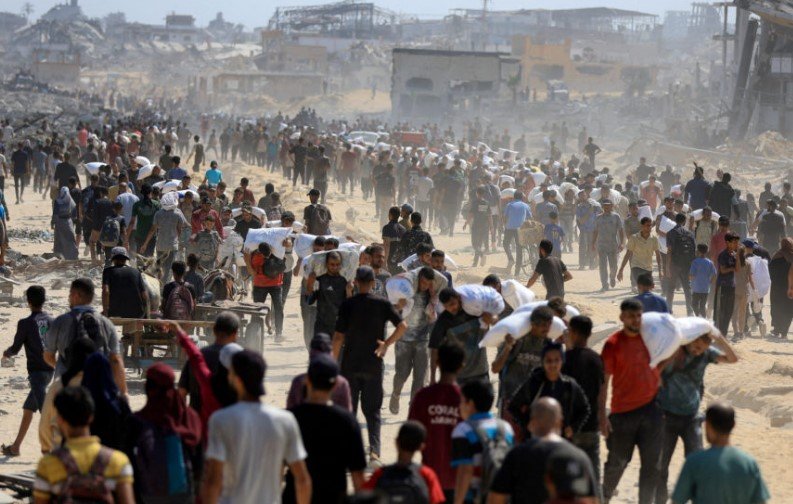37 Palestinians Killed in Aid Line as U.S. Scrutiny Grows Over Relief Efforts and Israel’s Strategy
It happened in a flash, again. Just before noon Wednesday in northern Gaza, the air filled with panic as gunfire tore through a crowd waiting for food. The scene was all too familiar. Dozens were killed—37 confirmed dead—while trying to secure humanitarian aid for their families. More than 270 others were injured, many of them teenagers. For local doctors, already struggling with no supplies, there was little they could do.
And while Gaza bleeds, high-level meetings in Tel Aviv loom. U.S. envoy Steven Witkoff is expected to arrive Thursday to assess the crisis and Israel’s response strategy. But many Palestinians, and some lawmakers in the U.S., are losing faith that diplomacy is keeping up with the suffering on the ground.
Chaos at the Aid Lines as Medical System Collapses
The latest killings occurred at a makeshift distribution point near Jabalia. Witnesses said Israeli forces opened fire as people gathered near aid trucks. The Israeli army claims militants were among the crowd. Locals insist they were hungry civilians.
Hospitals, if they can be called that anymore, are barely functioning. At Kamal Adwan Hospital, an exhausted nurse spoke through tears.
“We have no anesthesia. No gauze. No electricity. We cut clothes into strips,” she said, holding up blood-stained fabric. “Every hour, we lose someone we could’ve saved.”
Only one operating room in northern Gaza remains usable, and even that is considered unsafe. A senior surgeon, speaking anonymously, said most procedures are now done by flashlight.
One sentence here: Grief is the only thing that arrives on time.

The Numbers Are Staggering—and Still Climbing
It’s been 663 days since October 7, 2023. In that time, Israel has killed 60,034 Palestinians and injured 145,870, according to the Gaza Health Ministry. Most of the victims, they say, are women and children.
These aren’t just numbers. They’re teachers, students, grocers, tailors—people who once lived normal lives.
According to Save the Children, 70% of Gaza’s 1.1 million kids now show signs of severe trauma. And UNICEF reports that more than 80% of Gaza’s population is facing starvation-level food insecurity.
It’s a humanitarian implosion in slow motion. And yet, the war grinds on.
U.S. Envoy Witkoff’s Visit Sparks Skepticism
Steven Witkoff, a real estate developer-turned-diplomatic adviser, will visit Israel on Thursday. The trip comes amid mounting criticism of how the U.S. is handling its role in the region.
Witkoff is expected to meet with Israeli Prime Minister Benjamin Netanyahu and defense officials. A U.S. State Department official told reporters the visit will include discussions on “de-escalation, border logistics, and humanitarian entry points.”
But reactions have been mixed.
A Palestinian human rights lawyer based in Ramallah said, “What’s he going to see? Burned-out buildings? Mass graves? There’s nothing left to assess.”
Meanwhile, many in Washington are starting to speak out.
Democrats Demand Oversight of Dubious Gaza Relief Efforts
In an unexpected move, 93 House Democrats signed a letter to Secretary of State Marco Rubio demanding a full investigation into the Gaza Relief Foundation, a group contracted to deliver aid in the region.
The letter, made public late Wednesday, raised alarms over the foundation’s lack of humanitarian experience, lack of staff on the ground, and vague financial disclosures.
It also stressed a key point:
-
Delivering aid to Palestinians is not just moral—it’s a matter of Israeli and regional security, they said.
One Congressional aide, speaking off the record, hinted at deeper concerns: “We have no idea where the money’s going. Or who’s really distributing it.”
The State Department said it’s “reviewing the matter.” But no timeline for action was given.
Food as a Weapon, and Starvation as a Strategy
Human rights watchdogs say Israel is using starvation as a tactic of war. And they’re not mincing words.
“Denying food, bombing bakeries, blocking trucks—these are war crimes,” said Francesca Albanese, the UN Special Rapporteur on Palestine. “This isn’t collateral damage. It’s policy.”
Below is a breakdown of Gaza’s food access since January:
| Month | Aid Trucks Entering Gaza | UN Estimate of People in Famine Conditions |
|---|---|---|
| January 2025 | 245 | 1.2 million |
| March 2025 | 162 | 1.8 million |
| June 2025 | 109 | 2.5 million |
| July 2025 | 78 | 2.7 million |
In July alone, just 78 trucks made it into Gaza. That’s roughly one truck for every 30,000 people.
People have turned to eating animal feed, cardboard soaked in oil, and even grass.
One line here: Aid is not reaching the people who need it—because the checkpoints choke the lifeline.
What Comes Next? No Clear Answers
The future looks grim. Despite international outrage and growing dissent within the U.S. political establishment, there is no ceasefire in sight.
Sources close to the Israeli government say the military is preparing for a new phase in southern Gaza, possibly pushing toward Rafah again. The U.S. says it has “expressed concern,” but nothing has changed on the ground.
The families of those killed on Wednesday buried their dead quickly, without funerals. One man, clutching a torn backpack belonging to his son, whispered, “He just wanted bread.”
There’s no end in sight. Just more silence, more rubble, and more names added to an ever-growing list of the lost.
